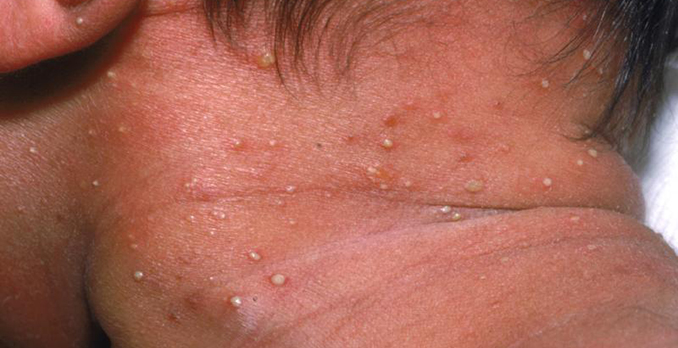
Differential Diagnoses:
Miliaria rubra
Neonatal acne
Acropustulosis of infancy
Bullous impetigo
Staphylococcal scalded skin syndrome
Diagnosis: Transient neonatal pustular melanosis (TNPM)
Learnings: TNPM is an idiopathic pustular disease of full-term newborns. Lesions begin in utero as pustules that then rupture, leaving behind collarettes of scale and hyperpigmented macules. Depending on the eruption’s stage of evolution, infants are born with some combination of pustules, scale, and hyperpigmented macules. The pustules and scale resolve within 2 weeks of birth, leaving behind hyperpigmented macules that persist for several months. New lesions do not form after delivery.
Parents should be reassured that this is a benign, nonscarring, self-limited disease that is not associated with any internal problems. No therapy is needed, because the condition is self-limited.
The pustules of TNPM are very fragile and often rupture upon removal of the vernix caseosa. Pustules may rupture in utero as well. Therefore, pustules may not be present on examination, leading the clinician to consider the diagnosis of multiple cutaneous lentigines. The hyperpigmented macules of TNPM, however, are less well defined than lentigines and are often surrounded by collarettes of scale in the first days of life. Furthermore, even when part of a syndrome (LEOPARD syndrome, Carney complex, or Peutz-Jeghers syndrome), lentigines tend to be few at birth and develop progressively thereafter, whereas the hyperpigmented macules of TNPM are numerous at birth and fade over time.
TNPM may also be confused with erythema toxicum neonatorum, which, unlike TNPM, is almost never present at birth and has significant underlying erythema.
What to Look For: The eruption presents at birth as some combination of pustules, collarettes of scale, and/or hyperpigmented macules affecting any cutaneous surface, including the palms and soles. Affected sites include the chin, neck, upper chest, lower back, and buttocks. Typically, all three stages are simultaneously present at birth. Pustules measure 2 to 6 mm in diameter and have no surrounding erythema. The pustules are very fragile and rupture with mild friction, leaving behind superficial collarettes of scale or brown crusts. In darker-skinned infants, lesions resolve with postinflammatory hyperpigmentation (hyperpigmented macules); however, pigmentation is usually not a feature in white infants.
Acknowledgment: Image courtesy of Logical Images, Inc. (www.VisualDx.com/JUCM)
